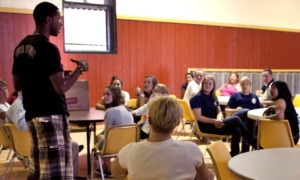
Sharan London
“To talk about a struggle, you’re likely to forget about it. To be shown a struggle, you’re likely not to forget it. But, to live through a struggle, you’ll understand it.”
―Valerie Owens, “America Huh! I’m Going Home”
On any given night in 2014, more than 216,000 American families were on the street or homeless. According to the U.S. Department of Housing and Urban Development (HUD) nearly 60 percent of those family members were children under 18.
While the total number of homeless individuals declined slightly during the last few years, the National Center on Family Homelessness reports historically high numbers of young people without permanent housing — approximately one in every 30 U.S. children.
Given the growing number of homeless families with young children, youth-focused programs are continually tasked with finding sufficient resources and effective partnerships to support them.
Homeless families often experience a range of issues that keep them from obtaining stable housing: limited education and work skills, low access to child care, substance abuse and domestic violence, as well as chronic mental and health conditions.
At the same time, most homeless families qualify for Temporary Assistance for Needy Families (TANF), but many have difficulty accessing and maintaining it due to TANF’s mandatory work requirements, such as job training and job search. In fact, recent data indicates that only 40 percent of eligible homeless families receive TANF.
Created through the Personal Responsibility and Work Opportunity Reconciliation Act of 1996, states receive federal TANF dollars in the form of block grants. These grants give states flexibility in how they use TANF funds to support families and children in poverty.
While states use about 29 percent of funds to provide cash assistance, they also use TANF to support child care, transportation assistance, subsidized employment, education and training, job search and rehabilitative services.
[Related: Photo Gallery — Counting the Homeless Kids in Atlanta]
Some states also use TANF funds to meet the housing needs of homeless families or those at risk of becoming homeless through rental assistance or eviction prevention support.
To address this housing gap, many TANF and housing service providers are partnering to better help homeless families access, maintain and benefit from TANF resources. They are doing so by:
- using TANF to connect homeless families to stable housing and employment opportunities. Many agencies use TANF funds to directly address housing-related needs. For example, the Mercer County, N.J., Board of Social Services uses TANF resources to assist families moving from shelters to permanent housing. Case managers from their Rapid Exit Team provide intensive case management and supportive services funded through TANF to stabilize families and connect adults to employment opportunities.
- co-locating TANF employment specialists at shelters. Some homeless families may be unaware of their eligibility for TANF. To connect families to TANF, better identify potential employment barriers and evaluate needed work supports, some agencies place TANF intake staff at shelters. In Salt Lake City, The Road Home staffs emergency shelters with TANF-funded employment specialists. As families enter shelters, the employment specialists conduct employment assessments and identify appropriate supportive services. Families who are rapidly rehoused from shelter receive up to four months of rental assistance funded through TANF while employment is secured.
- collecting and sharing data on homelessness. Other agencies collect information about housing status and risks of homelessness from TANF applicants, which is an important first step toward identifying families who are experiencing housing instability and who could use TANF assistance to avoid it. Some local jurisdictions have taken data sharing and integration across the TANF and homeless systems further. Development Services Agency staff in Hamilton County, Ohio, allow TANF workers to view client records of newly homeless families in the Homeless Management Information System to ensure connections to TANF-funded benefits and services.
- assisting homeless families to meet their TANF work requirements. As transportation, child care or other barriers may impede access to employment or work training, many agencies have begun assisting homeless families overcome these barriers to meet their TANF work requirements. In Massachusetts, Horizons for Homeless Children offers TANF-enrolled homeless families whose children are in their child care program the opportunity to spend time in their child’s classroom, followed by parental education and work-skills training classes. By participating in these activities, parents not only meet some of their work activity requirements but also develop valuable life and job skills.
Many states are also pursuing policy changes that better support homeless families. Some are adjusting cash benefit levels in relation to housing costs and applying for a waiver of the work participation standards for families experiencing homelessness.
TANF’s flexible funding structure allows states to develop programs in support of a wide range of activities, including homeless prevention and alleviation. To increase their effectiveness, many TANF programs forge cross-agency collaborations to address the complex barriers people who don’t have stable housing often face. These supportive housing and family self-sufficiency collaborations represent a vital resource toward ending family homelessness.
Sharan London, M.A., vice president at ICF International, leads the homelessness and supportive housing team, providing training and technical assistance to the U.S. Department of Housing and Urban Development’s Office of Special Needs Assistance. Patrick Heiman, M.P.A., is a training and technical assistance manager with ICF International who has nearly a decade of experience in the fields of TANF, Tribal TANF and rural poverty.
More articles related to this one:
Low-Income, Homeless Teens Use Art for Job-Readiness
Documentary on Homeless Teens in Chicago Aims to ‘Show the Struggle’
Music Program Helps Homeless, Runaway Youth Follow their Dreams
































